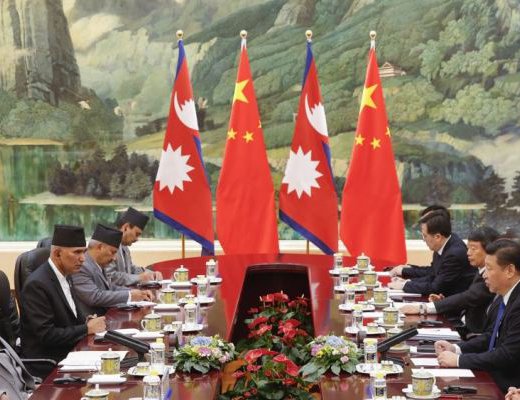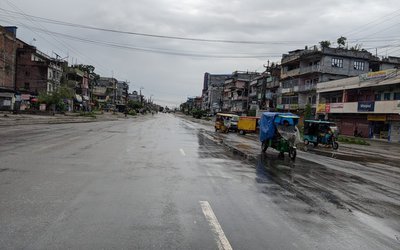
Although there are debates over the pros and cons of the recent agreements signed between Nepal and China when Nepalese Prime Minister K.P Sharma Oli was on an official visit to China, it will take a while to see how these will affect the power game in the Himalayan Region.
Scholars have been pointing at the emerging dynamics and strategic perceptions in the Himalayan Region for quite a long time. French career diplomat and political scientist Thierry Mathou, who is associated with the Department of Himalayan Studies of the National Center for Scientific Research, Paris, predicted the possible scenario a decade ago in his article Tibet and its Neighbors: Moving toward a new Chinese Strategy in the Himalayan Region.
Published in July-August 2005 issue of UC Berkeley Journal, Asian Survey, French scholar Mathou writes, “Until recently, China’s Strategy in the Himalayan region was essentially conservative because of recurrent tensions with India and defensive approach to the Tibetan issue.”
“With the easing of border tensions and implementation of the western regional development program, PRC is reconsidering the role of Tibet within its own territory and also in the Himalayan regional context. This does not mean, however, that China is taking a new approach on the Tibet issue; it only implies change of perspective in geopolitical terms. From being an underdeveloped and landlocked area located in the backyard of the Chinese territory far from Beijing, the Tibetan Autonomous Region (TAR) could become a bridge between China and South Asia.”
As dynamics are changing, they also alter the perceptions. After a meeting with Oli, Chinese Premier Li Keqiang said, "China looks forward to seeing a peaceful and prosperous Nepal."
"The two prime ministers made a comprehensive review of bilateral relations and expressed satisfaction over steadily growing relations between the two countries. The two sides exchanged substantive views on further strengthening and consolidating mutual trust and understanding as well as promoting mutually beneficial cooperation in various fields," Nepal's foreign ministry said in a release.
Chinese president Xi Jinping stressed the need for stability and prosperity in neighboring Nepal. "Nepal can be a bridge between China and India," Chinese President Xi Jinping said, putting his stamp of approval on the moves. He stressed China’s ‘One Belt, One Road’ project of transnational connectivity.
Leaning To China
Nepalese leadership looks towards China for survival following the promulgation of new constitution in Nepal. Ties between New Delhi and Kathmandu had soured after India refused to welcome Nepal’s new Constitution which India perceived as discriminatory towards ethnic Madheshis. This was followed by a five-month-long blockade of the India-Nepal border which severely curtailed the supply of fuel and other essentials to Nepal. Many in Nepal continue to believe that the blockade had clandestine support of India even though India vehemently denies this.
China wholeheartedly welcomed the new constitution as a political document for stability in Nepal. The five months of border blockade has apparently pushed Nepal’s new political leaders under an ambit of China.
In the last one decade, Nepal transformed from monarchical, unitary Hindu Kingdom to the secular, federal republic under an agreement brokered by India between seven parties and a Maoist alliance. Among others, with the abolition of monarchy and Hindu state, Nepal’s century’s long linkages to India on religion and culture have weakened.
“I don't think China would do anything in Nepal that would seriously hurt India’s interest and affect its own relationship with New Delhi,” Pramod Jaiswal, senior research officer at Institute of Peace and Conflict Studies in New Delhi, said.
Agreements Galore
Nepal and China have signed 10 bilateral Agreements and Memorandum of Understandings. The agreements include agreement on Transit Transport, Construction, Management and Maintenance of the Xiarwa Boundary River Bridge, (Hilsa) Humla, Economic and Technical Cooperation to implement Pokhara Regional International Airport Project and Framework Agreement on the provision of Mixed Loan between the Government of the People’s Republic of China and the Government of Nepal to implement Pokhara Regional International Airport Project.
Other agreements include Letters of Exchange on Project Initiation for the Feasibility Study on Chinese Assistance to Nepal for Exploration of Oil and Gas Resources, Memorandum of Understanding between the Ministry of Population and Environment of Nepal and National Development and Reform Commission of the People's Republic of China concerning the provision of goods for addressing climate change.
The agreements consist of Memorandum of Understanding between the Ministry of Industry of Nepal and State Administration for Industry and Commerce of the People's Republic of China to strengthen intellectual property system, Memorandum of Understanding between the Ministry of Commerce of the People’s Republic of China and the Joint Feasibility Study of China-Nepal Free Trade Agreement.
Chinese and Nepali officials have also discussed a range of projects in which Kathmandu needs assistance. Beijing has indicated it is ready to speed up the ongoing feasibility studies on projects such as maintenance of Araniko Highway, Syaphrubesi-Rasuwagadhi Highway. Kathmandu has also sought Chinese assistance for the preparation of Detailed Project Report (DPR) and construction of a dedicated two lanes Kimathanka-Khandbari-Dhankuta Road and upgrade Kathmandu Ring Road 2nd Phase.
Railway Link
Among others, Nepal China railways will likely change the geo-politics of Nepal giving Nepal another transit alternative. Prime Ministers Oli and Chinese leadership for the first time discussed a cross border railway project, involving extending China's Tibet railways into Nepal.
"Nepalese Prime Minister Oli raised proposals of two kinds of railways," Hou Yanqi, Deputy Director General in the Chinese Foreign Ministry's Asia Department. "The first is projects [within the territory] of Nepal connecting cities in Nepal, and the second is a cross border railway," she said.
Hou said the Nepal PM had "raised the issue of building a cross border railway between China and Nepal" and that the proposal "has got a positive response from the Chinese side and the two sides have agreed to conduct feasibility study at an early date."
Hou said China was already in the process of extending a line to the Nepal border, to Gyirong in Tibet, from Xigaze. The line from Lhasa to Xigaze was completed in 2014. "As for the cross border railway, China is already building a railway to Gyirong so this could be further extended," Hou said.
“China’s ability to provide an alternative for Nepal will also increase somewhat with the future completion of the projected rail lines from Golmud to Lhasa with the projected accelerated economic development of Tibet. Nepal will become far more able to balance economically between China and India, as Beijing anticipates,” writes French Scholar Mathou.
Indian Worry
Indian scholars hold the view that Nepali and Indian people share deep historical, cultural and religious bonds that China can never replace. However, Indian security analysts believe that the move has military connotations because the Himalayan Heights are a crucial strategic asset.
The Indian spokesperson has said Nepal has the right to seek other partners; but, some believe New Delhi may be concerned about the new situation because linking Nepal and China with railways would give the Chinese military a unique advantage over rival India.
“Nepal would not accept anyone’s 'hegemony'. We want to establish relations with both the neighboring countries (China and India) on the basis of equality, which should not cause irritation to any of the countries,” said Pradip Gyawali, a Central Committee member of the ruling CPN-UML party.
Indian analysts are angry when Nepalese Prime Minister Oli tried to match Pakistani leaders in their flattery of China. Prime Minister Oli said that "Nepal's relationship with China is higher than the Mount Everest and superior than the Great Wall.”
“In winning over Nepal, China has been cautious in not committing too much and avoiding roughing up Indian sensitivities beyond a limit,” tweeted professor SD Muni.
“If Beijing has not made a conscious decision to recognize Indian paramount in South Asia beginning with Nepal, one can expect continuing Chinese rivalry with India for influence in South Asia when circumstances are more propitious for Beijing,” American scholar John W. Graver predicted in 2001 in his book Protracted Contest: Sino-Indian Rivalry in the Twentieth Century.
Signing Transit Agreement and agreeing to expand the railway up to Nepalese border, China has shown that Himalayas are no longer any barrier for prosperity. As Nepalese Prime Minister Oli completed his visit to China, the test of his leadership will now be on how he will implement the agreements by balancing southern neighbor India, which is sensitive about the Himalayas for its internal security.
Given the past experiences, Prime Minister Oli’s visit to China and agreements signed with it will intensify the rivalry in Nepal between two powers resulting in a prolonged political instability in Nepal.

Keshab Poudel
Poudel is the editor of New Spotlight Magazine.
- ERC Nepal Is Focused On Expanding Distribution And Transmission To The Private Sector: ERC Chair Dr. Dhital
- Jul 06, 2025
- FOURTH PROFESSOR Y.N. KHANAL LECTURE: Nepal-China Relations
- Jun 23, 2025
- Colonel JP CROSS: Centenary Birthday
- Jun 23, 2025
- BEEN: Retrofitted For Green
- May 28, 2025
- GGGI has been promoting green growth in Nepal for a decade: Dr. Malle Fofana
- May 21, 2025















